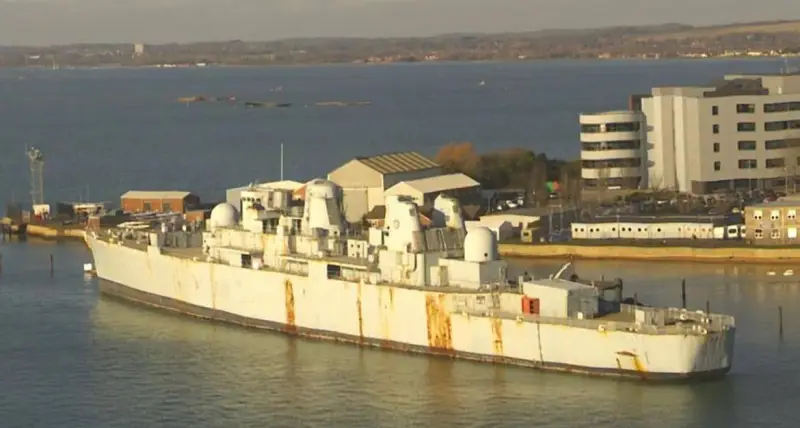Royal Navy White Elephant

I must admit that I always thought it was a two-pipe, judging by the profile photographs. It turned out that it was three-pipe. The aft two small pipes removed gases, each from its own gas turbine unit.
The ship was built as the lead ship in a series of eight Type 82 destroyers to accompany promising aircraft carriers. However, these aircraft carriers were not even laid down, and at the time the construction of aircraft carriers was abandoned, the Bristol hull was already at a fairly high degree of readiness. Dismantling would have required the same amount of time and money, so we decided to finish building it.
The ship, to put it mildly, turned out to be original, if not extravagant. What the designers were trying to achieve is still unclear to me. The power plant is a combined steam turbine plus gas turbine. It was assumed that the Bristol would run constantly in steam, and the GTA would be turned on for afterburner.
In reality, after the fire, the steam boilers were not restored, and the entire service was carried out on the GTA. Naturally, it could not reach the design speed of 28 knots, but this was no longer required.
"Bristol" received a very diverse bouquet, including the Limbo anti-submarine bomber from the Second World War, which no longer made any sense. However, it was removed fairly quickly.
Likewise, the Icarus anti-aircraft missile system did not take root on its deck. There was no clear explanation as to why it was abandoned. Perhaps they assumed that the anti-aircraft defense functions would be assigned to type 23 frigates.
Due to the fact that the ship was intended to escort aircraft carriers, it did not receive a hangar for helicopters, although there was enough space on the aft deck. Moreover, due to its size, the Bristol was a much better platform for helicopters than Type 42 destroyers or Type 23 frigates, but was not often used for these purposes.
The Sea Dart launcher was located in the stern and had a normal b/c 40 missiles, unlike the Type 42 destroyers, which had 22 missiles. In addition, the forward placement of the launchers and the “short” forecastle led to the fact that the Sea Dart launchers on Type 42 destroyers were very “wet”.
According to the recollections of the commander of the formation, Rear Admiral John S. Woodward, a very dangerous situation arose a couple of times.
Once the hatch covers were deformed by wave impacts, and the missiles could not be fed onto the guides at all. After the alarm was cleared, the sailors used sledgehammers to “straighten” the lids.
The second time, the missiles were already on the guides, but the splashes of sea water that settled on the surface of the guides and missiles formed a thin salt crust, which caused the microswitches to fail. The missile defense system was on the guide, but the control electronics did not see it. Fortunately for the “enlightened sailors,” the Argentines were not able to take advantage of such gifts.
"Bristol" also took part in the Falklands War. Because it had a Type 965 long-range radar and as many as 2 Type 909 CHs, unlike the Sheffield-class destroyers, which had one Type 909 CH.
Due to its low speed, it was not suitable for the “first line”, but it was quite suitable for covering landing ships and “floating rear” vessels. He even carried out several launches of the Sea Dart missile defense system, but without success.
Since 1993 - a training ship.
And so, you need to understand, in the near foreseeable future the last British steamship will be completely decommissioned and sold for dismantling.
Information